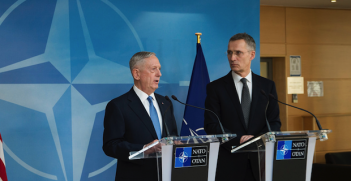The Warsaw Pact: Forgotten Relic of the Cold War

Sixty years after the signing of the Warsaw Pact on 14 May 1955, relations between Russia and Western Europe remain fraught with tension.
This week marks the 60th anniversary of the establishment of the Warsaw Treaty Organisation (WTO), better known as the Warsaw Pact. Up until at least 1991, European and even global security concerns were understood through interpreting the relationship between the Warsaw Pact and its security ‘other’, the North Atlantic Treaty Organisation (NATO).
Established on May 14, 1955, the official aims of the Warsaw Pact were to safeguard the security of its member states and to increase military cooperation amongst its members. But it was more than just a collective defence alliance. It also served as a mechanism through which the Soviet Union could legally maintain a military presence in its satellites; Bulgaria, Czechoslovakia, the German Democratic Republic (GDR), Hungary, Poland and Romania (Albania was a founding member, but left in 1968). This military presence also served as an apparatus for coercion over its allies.
Despite popular opinion, the Warsaw Pact was not established in direct response to the establishment of NATO in 1949. Rather, as promised by the Soviet leadership at the time, its formation was retaliation for the remilitarisation of West Germany and their subsequent inclusion in NATO.
Again, while primarily a defensive alliance, without doubt the single most important event in the history of the Warsaw Pact was the only time that its troops were deployed for ‘real’ military action: the invasion of Czechoslovakia in August 1968.
In April 1968, under the leadership of Alexander Dubček, the Czechoslovak Communist Party published their ‘Action Plan’; a document that advocated what became known as ‘socialism with a human face’. Soviet fears that the reforms advocated would lead to instability, particularly in the GDR and Poland, led them to indulge in a variety of dissuasive methods. At a Warsaw Pact member meeting in early July, Czechoslovakia was simultaneously reprimanded and threatened. Moscow next initiated a more ‘traditional’ form of intimidation; they announced large-scale military manoeuvres to be conducted along the Czechoslovakian border. Then, on the night of 20 August 1968, without any warning, Warsaw Pact forces invaded Czechoslovakia. While exact numbers of the invasion force are unknown, it is generally accepted that it constituted the largest military operation in Europe since the end of the Second World War.
The aftermath of the Prague Spring served primarily to tacitly codify the respective spheres of influence in Eastern and Western Europe. It was clear after the events in Hungary in 1956 and the suppression of the Prague Spring that no Western country would intervene in Eastern Europe under the pretence of protecting ‘democracy’. This was further evinced by Western acceptance of the so-called Brezhnev Doctrine; the right of the Soviet Union to defend, militarily if need be, socialism in any part of the ‘Socialist Commonwealth’ (replaced in 1989 by Eduard Shevardnadze’s ‘Sinatra Doctrine’).
It would be wrong, however, to think of the Warsaw Pact as a Soviet dominated monolith. Its history is replete with ructions over leadership (a Soviet was always Commander-in-Chief), involvement in military activities (Romania refused to participate in the 1968 invasion of Czechoslovakia) and, in the 1980s, the GDR and Czechoslovakia objected to the deployment of Soviet-controlled nuclear missiles on their territory. Nonetheless, throughout the Cold War, the Warsaw Pact remained the primary Soviet-backed military alliance; its relationship with NATO was the lens through which many observers understood the Cold War.
The Warsaw Pact’s demise, in many ways, could be regarded as signalling the end of the Cold War. While Mikhail Gorbachev had relinquished control over the affairs of Warsaw Pact members, he was of the opinion that the alliance could still serve a political, if not military, purpose. However, such a view was not shared by the newly emerging post-Communist states in Eastern Europe. In early 1991 Czechoslovakia, Hungary and Poland announced that they would cease cooperating with the WTO (to rub salt into Gorbachev’s wounds, Hungary announced that it would be accepting an invitation to join NATO as an associate, non-voting member). Subsequently, the Warsaw Pact was officially disbanded on the 1st of July 1991 (although as a number of scholars note, from December 1989 onwards it had neither an ideology nor a hegemonic power to hold it together).
But this is not the end of the story. While the new Russian leader, Boris Yeltsin, did not initially oppose former Warsaw Pact countries joining NATO, by 1993 he was objecting strongly to NATO’s eastern expansion. Informed by an unease of involving itself in a conflict between Russia and its former WTO allies, NATO established the ‘Partnership for Peace’, which allowed for former-Warsaw Pact countries to participate in select NATO exercises without the promise of membership. Nonetheless, by 2004, all the former members of the Warsaw Pact were full members of NATO (Hungary, the Czech Republic and Poland having joined first in 1999). However, despite NATO’s good intentions, the current crisis in Ukraine can be directly attributed to the West’s post-1991 hubris; the overtures to more than willing former Soviet republics and Warsaw Pact members to join NATO has done little more than agitate an already suspicious, fragile and aggrieved Russia.
The Warsaw Pact is now a much-forgotten relic of the Cold War. Nevertheless, on the 60th anniversary of its establishment, it is worth reflecting on its existence and demise, even if for no other reason than the possible insights it offers us into current events in the former-Soviet sphere.
Dr Matt Killingsworth lectures in international relations at the University of Tasmania. He is the author of Civil Society in Communist Eastern Europe and co-editor of Violence and the State, forthcoming. This article can be republished with attribution under a Creative Commons Licence.





